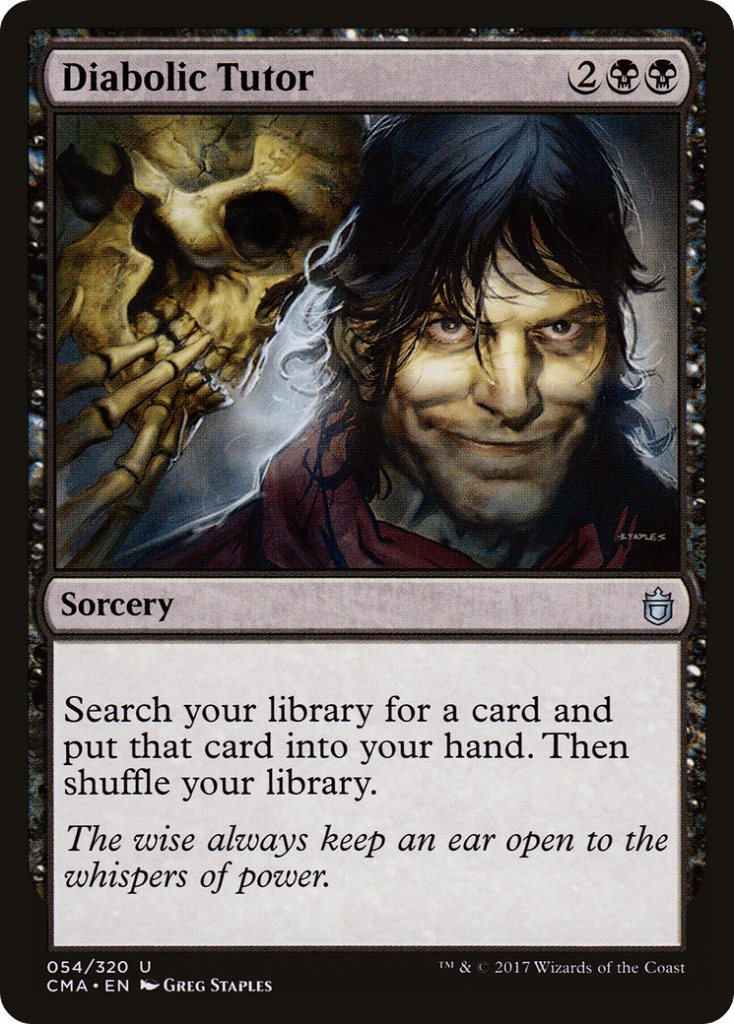
When playing in a format where your deck (library) is 99 cards and you’re only allowed to play 1 copy of any card that isn’t a basic land, the odds of drawing the card you need when you need it are pretty slim, usually ending up between just 1 and 2 percent during a game of Commander.
But what if you could improve those odds by playing cards that let you effectively draw any card you want? Wouldn’t you run as many cards like that as you possibly could?
While many will initially exclaim “Of course I would!”, this doesn’t actually work out to be the case for anyone in reality. Why, you ask? Let’s take a closer look by examining what these cards, referred to as tutors, actually are, how they work, and what makes one worth playing.
What are Tutors in MTG?
The term tutor dates back to Demonic Tutor from Limited Edition Alpha, a card that lets you search your deck for a card of your choice and adds it to your hand. This idea was expanded upon slightly in Mirage a few years later to include cards like Worldly Tutor that search your deck for a specific type of card, in this case a creature, and places the tutored card on top of your deck.
While this definition is what most Magic: The Gathering (MTG) players will default to when asked what they consider a tutor, I’d argue the concept has become a bit broader than that since the 1990s. Here is my definition of a tutor:
A tutor in MTG allows you to search a library for 1 or more cards, then place the selected cards in a more accessible location, such as your hand, the top of your deck, your graveyard, the battlefield, or in exile.
This differs a bit from the traditional definition in a couple key ways:
- A tutor isn’t limited to searching your own library
- A tutor isn’t limited to putting a card in your hand or on top of your deck

Naturally, searching a library that isn’t your own introduces a certain amount of risk, as your knowledge of the deck you’re searching is going to be imperfect at best, and nonexistent at worst.
You might be able to make an educated guess as to whether a card you need is going to be in a specific player’s deck based on their commander and perceived budget, but that’s far from a guarantee as they are just as likely to have forgotten to include the card you’re searching for or simply haven’t bought a copy of it yet.
Additional risk is also assumed when tutoring for cards that aren’t going to a place where you can’t immediately play them or protect them for later use, such as the graveyard, and this is especially true if you have to reveal the card(s) you searched for.
This is because information and time are a very disruptive combination in the hands of your opponents. Together, they can give the table time to prepare anything from a piece of removal to a counterspell to address the threat you’ve shown, minimizing its impact or rendering it completely useless.
Fortunately, black is the color best suited to avoiding these common weaknesses, as you’re usually able to search for any card at a low mana cost when using its tutors, and since there aren’t restrictions on the type of card you can search for, you almost never have to reveal what you retrieved to the table.
What Do Good Tutor Spells Do in MTG?
A good tutor spell in black has most or all of the following qualities (in order of importance):
- Costs 3 mana or less when searching for a single card (4 is occasionally acceptable if it finds 2 cards)
- Puts the tutored card in a place where you can quickly or immediately use it
- Doesn’t prematurely tell your opponents what you searched for
Mana cost’s importance to the quality of a tutor cannot be overstated. Since you’re using a tutor to draw the card you were actually searching for, it’s like you’re spending extra mana to play that card once you get it. The less your tutor costs, the lower the tax placed on playing your card during the same turn.
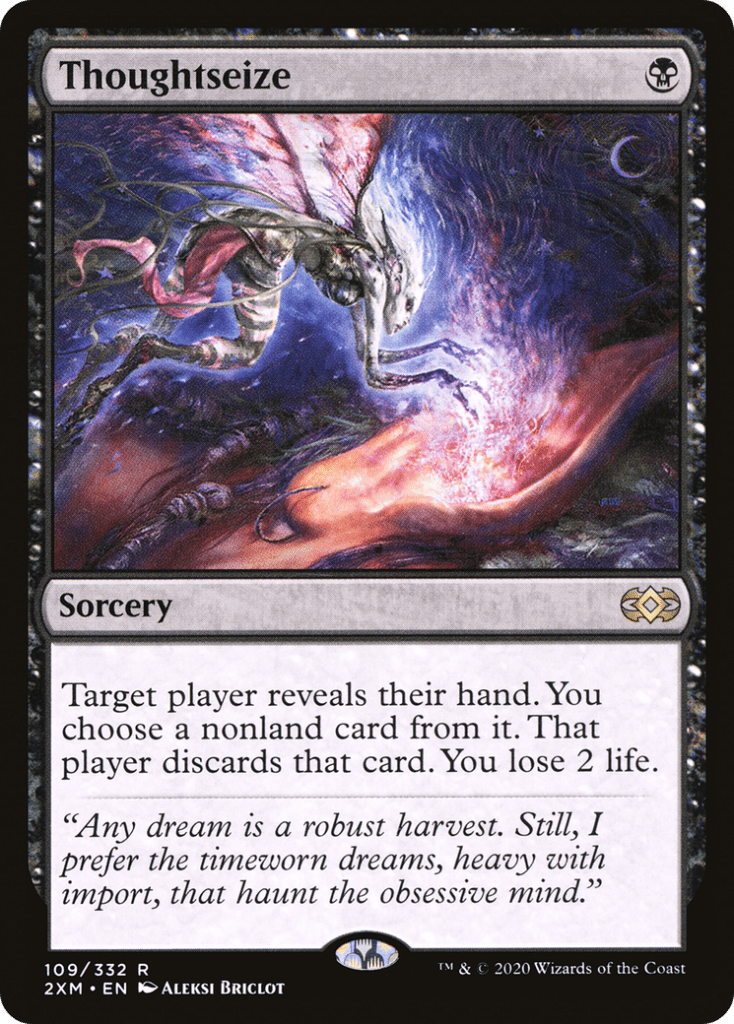
Your hand is usually the safest place a tutored card can go, as hand disruption is fairly uncommon at Commander tables. Placing cards on top of your deck is also usually okay, but there are plenty of cards that can make a player mill, or discard cards off the top of their deck, so you’ll want to keep an eye out for those beforehand.
We’ve already touched on the importance of not giving your opponents more information or time than you have to, but as it’s good advice for Commander games in general, it bears repeating here as well. If you have to give up information during a Commander game, be prepared to minimize the window of time your opponents have to act on it.
Since tutors are a little more flexible in how they operate than other types of cards, we’re going to look at unusual ones first, including those that are generally used in specific cases, before ranking the remaining generically good ones.
As with all placements, cards are loosely listed from worst to best, with the caveat that positions can change based on opinions or the situation during a game.
Graveyard Tutors (Buried Alive, Unmarked Grave, Entomb)
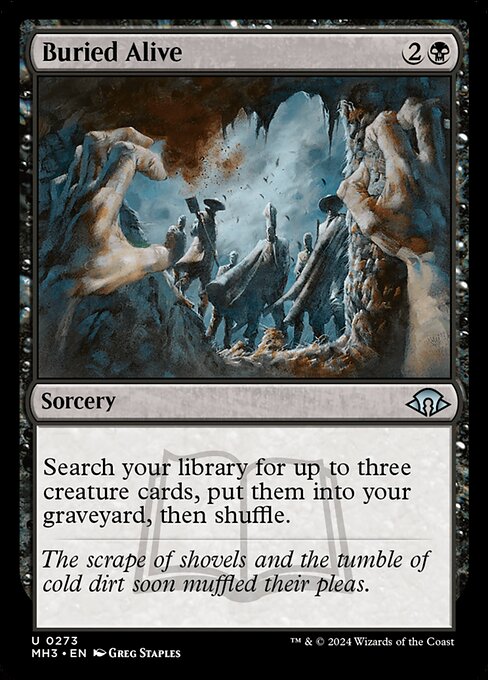


Despite spells that put cards in your graveyard are commonly used with reanimator decks in Commander, they often have applications that go beyond this specific strategy. Buried Alive, for example, can put creatures like Anger, Anathemancer, or Stinkweed Imp into your graveyard to give your creatures haste, deal damage to a greedy manabase, or prepare a consistent way to fill your graveyard.
Entomb and the “fixed” version of it, Unmarked Grave, are far more flexible, allowing you to set up spells with flashback like Past in Flames, additional static benefits through cards like Riftstone Portal, or simply open up more targets for you to recover through an Eternal Witness.
Though they are similar, each of these cards also brings specific strengths to the table when compared to the others. Buried Alive costs the most to cast, but also fetches 3 specific cards for 3 mana, a rate that is unparalleled.
Entomb, as a cheap instant, can be set up from the start of the game at the end of an opponent’s turn, and is extremely unobtrusive when setting up plays later on. Unmarked Grave nicely fills a middle ground that is more flexible than Buried Alive, but more fair than Entomb in terms of restrictions, mana cost, and casting speed while still being efficient.
While not for every deck, these cards definitely don’t see quite as much play as they really should, and should be considered for any deck containing several cards that benefit from interacting with your graveyard.
Shared Tutor Effects (Scheming Symmetry, Wishclaw Talisman)
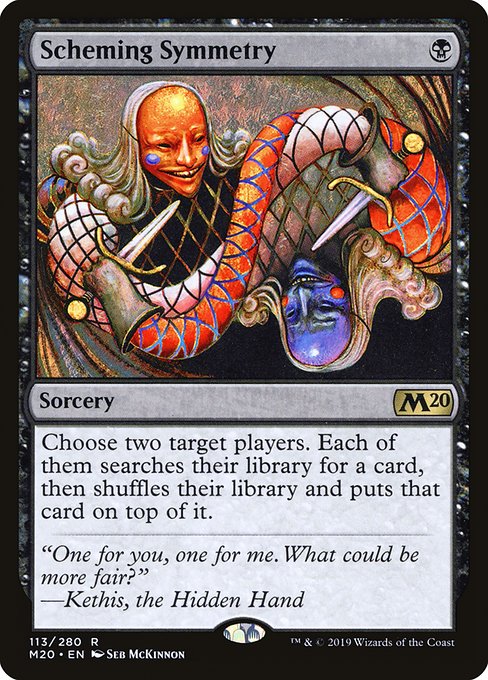
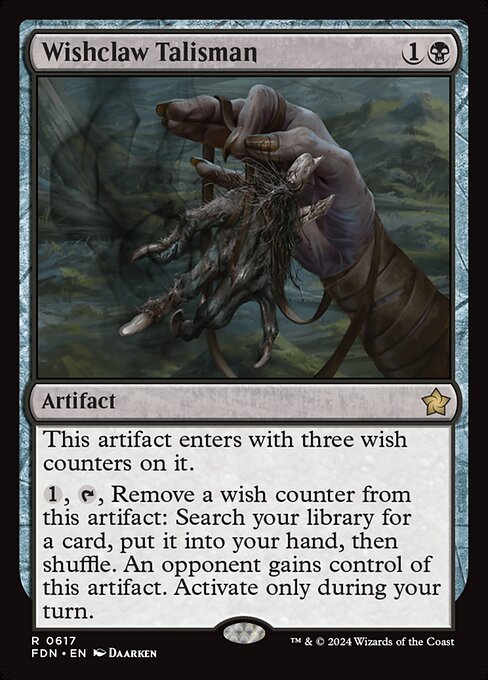
Tutors like Scheming Symmetry and Wishclaw Talisman are the first tutors to really explore the design space of tutoring for what you want, but allowing an opponent to do the same in exchange. While serving as budget versions of less conditional tutor effects, each is surprisingly powerful and can be a huge boon when used to its full potential.
Scheming Symmetry plays a role akin to that of Imperial Seal; you get to search your deck for a card and put it on top for 1 mana – but so does another player of your choice. While extremely advantageous if you’re playing a game of 2-Headed Giant, realistically, it means one of your opponents is going to get to take advantage of this effect ahead of you.
In many cases, this isn’t a big deal. A little table talk can easily get players to compete for your favor in exchange for not using their tutored card against you or using the opportunity to solve a shared problem. Politics gets a little trickier when you’re clearly ahead, however, as people are often less inclined to make concessions to the player who’s winning.
Fortunately, there are also lots of ways to tip the scales in your favor if you aren’t using Scheming Symmetry for political purposes. Black has access to ample card drawing spells, which will allow you to snag your card before the other chosen player. Milling the card your opponent searched for will also get the job done quite nicely.
Commanders like Jeleva, Nephalia’s Scourge and creatures like Etali, Primal Storm can actually spin this drawback into a positive, exiling powerful cards from the less aware and giving you access to them instead. In a worst case scenario, your opponent searches for a basic land and doesn’t get to take advantage of your “generosity”.
Similar treachery can be performed with Wishclaw Talisman by using a card like Brooding Saurian, but unlike Scheming Symmetry, the talisman is usually a better fit for table politics for a couple reasons.
First, you get to use the effect of Wishclaw Talisman before anyone else, ensuring you get to set the pace for the situation at hand. Second, you can usually talk your way into having the opponent send the talisman back to you for its last activation once they’ve used it, ensuring you get 2 unconditional tutor effects for 4 mana spread out over a couple turns.
If you’re particularly slick, you can sometimes even get an additional concession such as not being attacked out of them too!
Tutors For Your Opponent’s Library (Praetor’s Grasp, Opposition Agent)

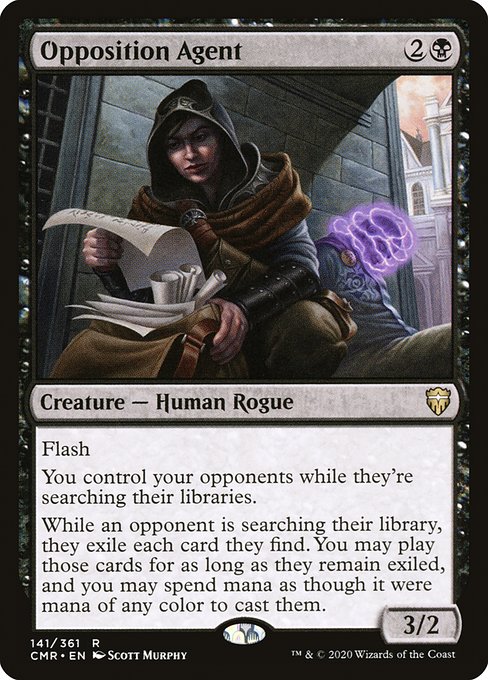
One of the earliest lessons I learned in CCGs as a Yu-Gi-Oh! player was that your opponent usually has the answer to a problem that’s on the board. While card designs precisely like Exchange aren’t part of Magic’s card pool, Praetor’s Grasp has reinforced this fact time and again for me in Commander games over the years.
Being able to search any opponent’s library and exiling it face down for your use is incredibly powerful. Need a huge boost in your mana? Snag a Cabal Coffers. Want a get out of jail free card when someone goes off? Teferi’s Protection has your back. Simply want to put an infinite combo out of an opponent’s reach? Just take a part of it and forget about it.
Best of all, your opponent isn’t going to know what you tutored for, and that uncertainty in and of itself is a powerful tool. Maybe they’ll play a tutor to try and figure it out, but the longer your stolen card goes unused, the more likely it is they (and the rest of the table) will forget about it entirely, which can lead to a major gameplay mistake during a crucial moment.
As powerful as Praetor’s Grasp is, Opposition Agent makes it look incredibly weak by comparison. In exchange for exiling your tutored cards face up, you get to effectively steal opposing tutors for yourself, and you can spend mana as thought it was mana of any color to cast your stolen cards.
Better yet, this tutor thievery is stapled to a creature, effectively shutting down all opposing tutors until it is removed from the battlefield.
Having played with this card a fair bit since its release in Commander Legends, its power is simply undeniable. To the point it really doesn’t feel fair. Mana ramp like Nature’s Lore, fetchlands like Misty Rainforest, effects like Birthing Pod – the sheer number of cards Opposition Agent disrupts is staggering.
I’ve also noticed it really brings down the mood of casual playgroups, as having your card effects simultaneously stolen from you and used against you doesn’t feel especially good.
While Opposition Agent was clearly intended as a tool to fight against higher power decks, it also simultaneously feels like a Stax card (a strategy intended to deny your opponents resources, primarily through mana disruption), a counterspell, and a Word of Command all wrapped up in a 3 mana package, and its impact has reached far beyond the intended purpose.
In short, if you’re going to play this card, take a little extra time to assess your playgroup’s power level and demeanor when deciding how to use it. It’s very rare that I take this into account when building or playing my decks, so the fact that I’m taking the time to specifically call Opposition Agent out should speak volumes.
cEDH Tutors (Tainted Pact, Demonic Consultation)

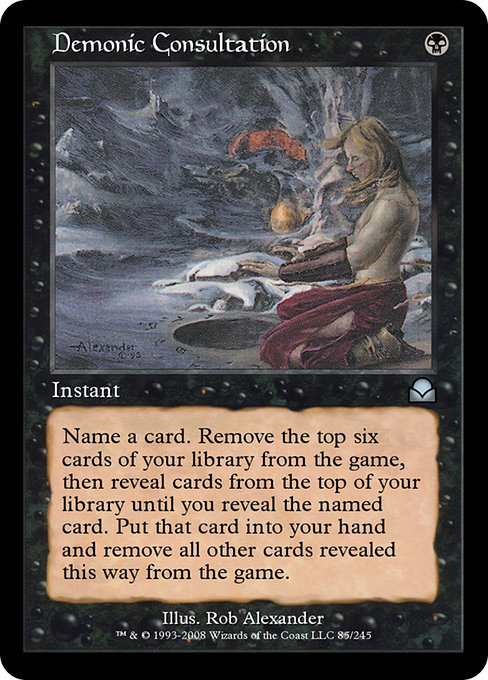
Tainted Pact is a card that rewards you for building your EDH deck like a true highlander deck, only allowing you one copy of any given basic land in addition to Commander’s normal restrictions. Once done, you have a 2 mana instant that can find you any card you need while exiling all cards that happen to be above it in your deck.
While this is certainly easier to do in 4 color partner builds or 5 color decks, as those mana bases usually need to lean almost exclusively on basic lands to ensure consistent access to all colors, there are more than enough nonbasic lands out there at this point that you could play this instant speed tutor in any deck containing black.
But who am I kidding – if you’re playing Tainted Pact, especially in cEDH, its primary job is to combo with Thassa’s Oracle to win the game.
Demonic Consultation is used the same way, but has considerably more application while not imposing the same deckbuilding restrictions. While using it carries a small risk, so long as your named card isn’t in the 6 cards you exile, you can find the card you need at the end of an opponent’s turn, then have access to all your mana to cast the tutored card on yours.
This is what makes instant speed tutoring so powerful, and while both of these cards are generally considered combo pieces, discounting their intended purpose as tutors is a tremendous disservice when evaluating their power level.
Beseech the Queen
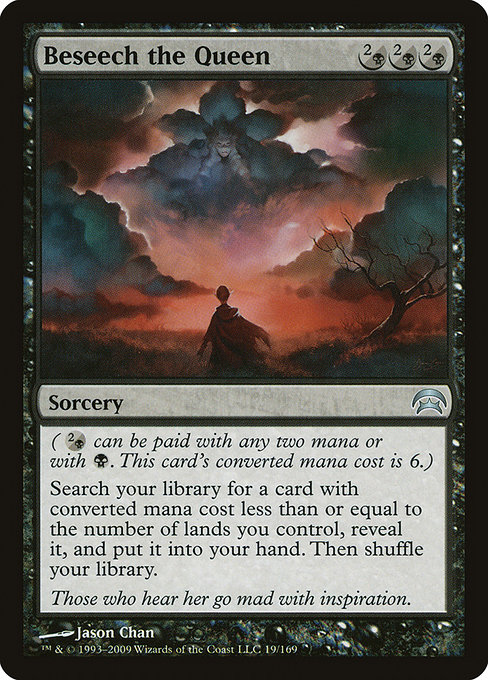
I’ve played Beseech the Queen for a long, long time. For years, it was the best budget tutor, and it still holds its own today, but as more cards get printed and the format’s speed continues to increase, its flaws start to become more and more apparent.
First, you’re only allowed to search for a card with a mana value less than or equal to your land count, which means you have to reveal what you’re looking for. While not a dealbreaker if you’re grabbing a land or a mana rock, the more significance your card has to the current board state, the more of a problem showing it off becomes.
Second, while it’s nice to be able to cast this card for more mana if you can’t assemble 3 black mana sources, it’s only efficient if you’re able to jump through that hoop. Diabolic Tutor hasn’t been good in this format for a long time, and most 5 mana tutors are unplayable in many playgroups today because they’re just too slow.
With these shortcomings in mind, I generally reserve Beseech the Queen for 1-2 color decks, or any deck that can consistently access Urborg, Tomb of Yawgmoth early in the game.
Demonic Bargain

Demonic Bargain, on the other hand, is a budget tutor I can get behind in today’s meta. Despite costing 3 mana, there’s only 1 black pip in its mana cost, making it easily accessible to any black deck, and then you simply get to find any card you want from your deck and put it into your hand without any fuss.
Assuming you don’t accidentally exile it.
Fortunately, the odds of that are quite low. Exiling 13 cards off the top of your library represents a rough 1 in 6 chance that you’ll lose access to the card you need, with the odds improving to around 1 in 7 in the early game, and dropping as low as 1 in 5 if the game drags on for a while.
This means the odds are quite favorable, and I’d assume this risk in a heartbeat so long as the deck I’m piloting isn’t a dedicated combo deck. When you rely on very specific cards to win, the risk presented by Demonic Bargain is considerably more dangerous, as exiling a key card can take you out of the game instead of creating a significant inconvenience.
Profane Tutor

We’ve seen a lot of cards try to be the “fixed” Demonic Tutor over the years, and regrettably, Profane Tutor falls far short of its predecessor due to how slow it is.
That said, having to wait 2 turns for your payoff isn’t always a bad thing.
At worst, Profane Tutor offers benefits similar to instant speed tutors like Tainted Pact. You’ll be able to search for any card you need at the start of a future turn, then have access to all your mana to cast either a big threat or part of a series of cards to do the same. Not at all bad, especially since the state of a board can shift dramatically over the course of 2 turns.
That last detail is especially important in the early game, before a clear threat has presented itself. You might not have an urgent need for a specific card on turns 2-4, so rather than potentially wasting a tutor on a card that could be rendered useless as the game develops, you can simply set yourself up to make a more informed decision later.
Grim Tutor
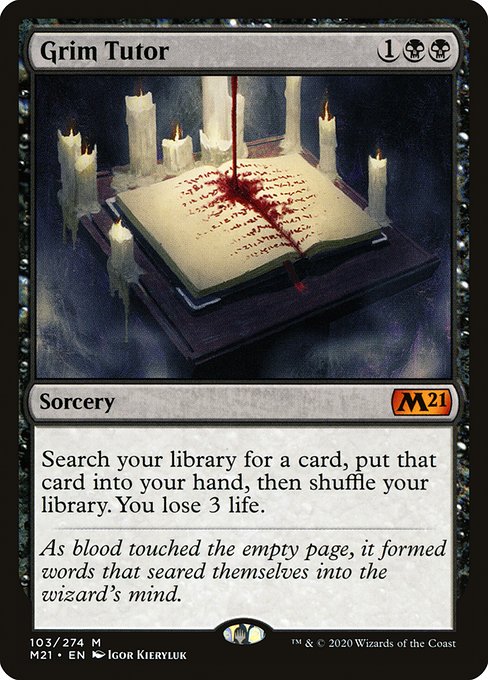
I am so, so happy this card finally got a reprint in Core Set 2021. Grim Tutor was over $100 per copy for over a decade because it was only available in Starter 1999, and since it wasn’t on the Reserved List, I simply couldn’t justify that price tag when literally any other tutor, even the better ones, was far more accessible.
Easily the best of the 3 mana tutors, being able to find any card in exchange for 3 life is a bargain in Commander, where your starting life total is 40. While a mana value of 3 is a pretty steep ask in cEDH, any other Commander deck containing black is usually improved by playing Grim Tutor.
Diabolic Intent
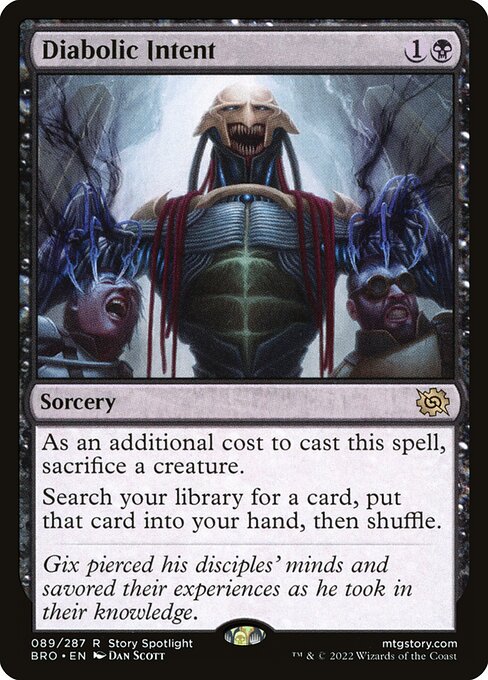
It took me a long time to come around on Diabolic Intent. While a very efficient tutor for the mana cost, sacrificing a creature was a pretty big ask when the Commander format was slower, running more akin to a battlecruiser environment full of big creatures slugging it out than the much more intricate version we play today.
These days? Cost of doing business. Diabolic Intent is definitely not for every deck, but if you play a lot of efficient creatures or find that your playgroup is prone to board states that stall out leaving everyone looking for answers, consider giving this card a chance to break the ice and propel you to victory.
Bonus points if you can use it in conjunction with cards like Blood Artist, Undying Evil, or Filth to get some extra bang for your buck.
Imperial Seal and Vampiric Tutor
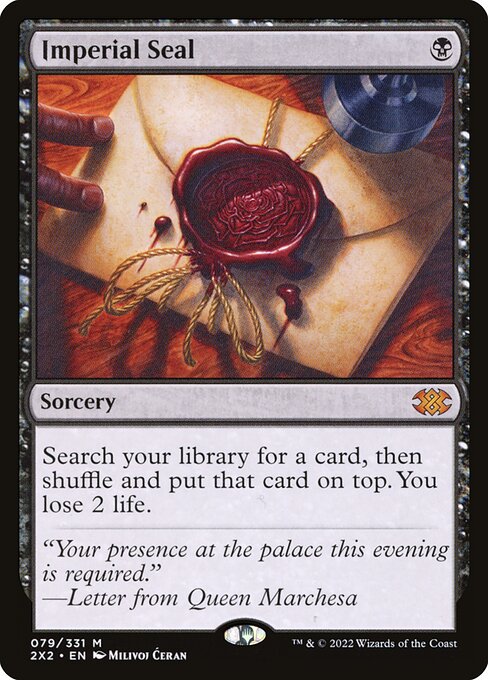
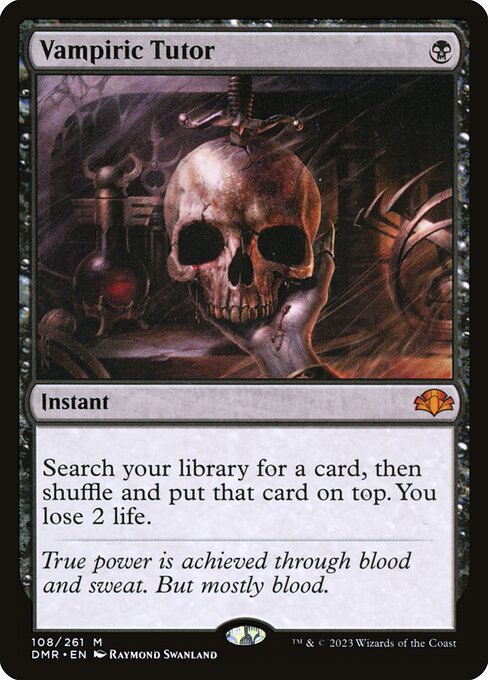
Pay 1 mana (and 2 life), put any card in your deck on top of your library. Simple, elegant, and insanely powerful.
Imperial Seal and Vampiric Tutor have set up everything from miracle cards like Terminus to game winning combos like Kiki-Jiki, Mirror Breaker and Pestermite in my decks, and continue to be some of the best tutors in the game despite having been around for over 20 years.
If simply getting the best card in your deck isn’t enough, they also do a good job of both shuffling and arranging your library, breathing new life into what you see with cards like Sylvan Library, setting up tricky plays with Sensei’s Divining Top, or setting up a devastating one-two punch with Sunbird’s Invocation.
Regrettably, Imperial Seal hasn’t been appropriately reprinted, as there just aren’t enough judge promos to go around and Double Masters copies are still pricy. On the bright side, Vampiric Tutor is the better card due to being an instant, and has been made recently available again in Commander Legends, so finding it is comparatively easy compared to recent years.
One other interesting area of note – Imperial Seal and Vampiric Tutor are ideal for showcasing the importance of card advantage vs card quality.
Card advantage is pretty easy to understand – at worst, you generally want 1 of your cards to trade with one of your opponents’ cards, like when your Doom Blade kills an Eidolon of the Great Revel. If you play a Divination, you’re trading 1 card for 2, which is inherently considered good card advantage.
Years ago, it was common practice for this to be most, if not all that was considered when measuring a card’s power level. Current staples like Force of Will were disregarded simply because it was a 2 for 1 in your opponent’s favor, despite being able to counter any spell for free!
Card advantage is still very important to consider today, but its importance also has to be measured alongside the quality of the card(s) you’re looking at.
If that earlier Doom Blade instead kills a Baneslayer Angel, you come out a little ahead because you used a 2 mana card to kill a powerful 5 mana creature, spending less mana than your opponent. If you play a Divination instead of a Touch of Brilliance, your mana cost is lower for the same 2 cards, making Divination the higher quality card for the same effect.
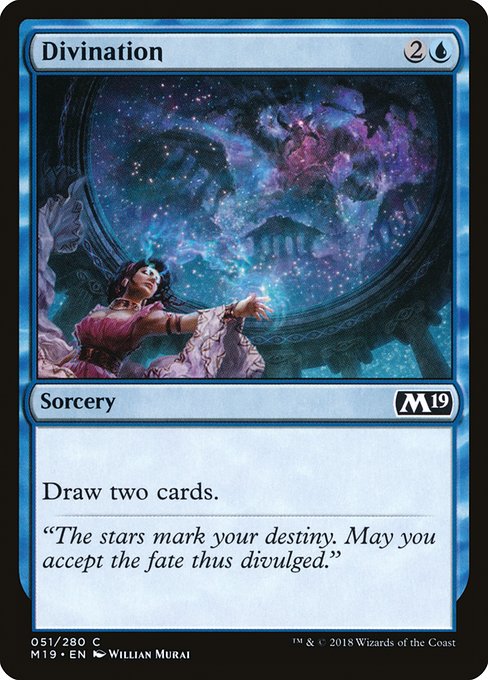
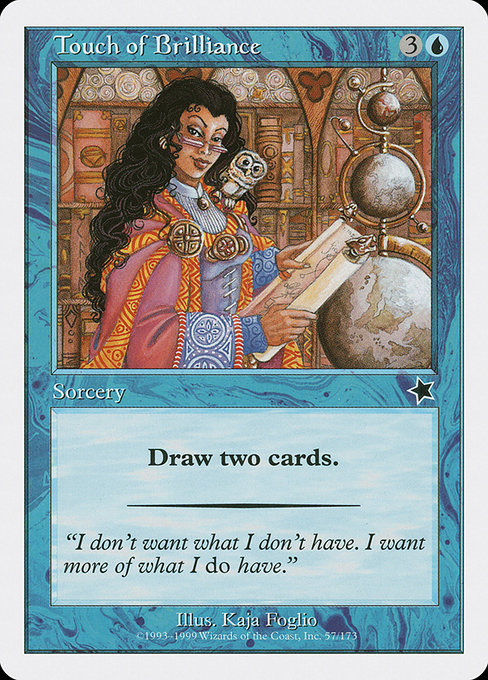
Measuring card quality gets considerably more complicated once you go beyond these simple examples, but the basic idea that “higher quality cards generally make it easier to win games” is all that’s really needed to highlight what actually makes these 1 mana tutors so powerful.
Applying these quick lessons to the subjects at hand, Imperial Seal and Vampiric Tutor inherently trade themselves for nothing up front, which isn’t going to look good from a card advantage perspective, especially if you don’t have enough time to draw the card they tutor.
But for only 1 mana, that card is going to be the best, highest quality card your deck has to offer, possibly netting you a lot of card advantage through a board wipe, stopping someone else from doing the same to you with a counterspell, or setting you up to complete an infinite combo!
Ultimately, your tutored card’s goal is to make it easier for you to win the game.
Once you’ve won a game of Magic, then it ultimately doesn’t matter which cards your opponents had or how many they’ve amassed. You might have given up a little card advantage to close the game, but that detail ultimately becomes unimportant once you stand victorious.
While oversimplified, the concept of card quality quickly gets to the root of what makes Imperial Seal and Vampiric Tutor (heck, tutors in general) as strong as they are, how their power level scales as high as it does, and why they’ll continue to see play for years to come.
Demonic Tutor

As powerful and efficient as all the tutors are that we’ve looked at today, none holds a candle to the original. 2 mana places any card from your deck into your hand, with no drawbacks or strings attached.
Instant access to the exact card you need will usually have a significant impact on the board state, up to and including a chance to win the game outright. Demonic Tutor‘s speed of access and improved card advantage more than makes up for the extra mana spent over Vampiric Tutor and Imperial Seal.
TL;DR: Your deck is simply better for including this card if it can play it. There’s a reason we haven’t gotten anything close to its level of efficiency in 30 years.
How Many Tutors Should an EDH Deck Have?
If consistency or winning are your primary goals, playing as many efficient tutors as you can fit in your deck is generally good advice. Numerically, this usually works out to be between 6-10 cards for me, especially if my commander has black in their color identity, and this seems to be a fairly common range for many other players as well.
Combo decks that focus on assembling very specific cards might go beyond 10 tutors, but oftentimes, these extra tutors are more situational and unnecessary for the average Commander player.
If your Commander deck doesn’t have access to black and its array of universal tutors, focus on choosing low mana value tutors that fit in well with your strategy (for example, don’t play Idyllic Tutor when your deck only has 4 enchantments unless they’re of critical importance).
Finally, don’t be afraid to look at black tutors beyond this list if they make sense for your deck. Some of the tutors with a higher mana cost or more situational effects work really well in specific strategies, so evaluating them is also important when building your deck and deciding on how many tutors you should be running.
Other MTG Articles You Might Enjoy
- MTG’s Best Green Mana Ramp Cards for EDH
- MTG’s Best White Mana Ramp Cards for EDH
- MTG’s Best Mana Rocks for EDH
- Spelltable Camera Setup
- The Best Reanimator Commanders in MTG
Braden is a founder of Assorted Meeples and has been a gamer & writer with a vivid imagination all his life. Don’t believe us? Check out his excitement when meeting Goosebumps author R.L. Stine as a kid! An avid Magic: The Gathering spellslinger for over 15 years, you can always convince him to shuffle up for a game (or three!) of Commander.
